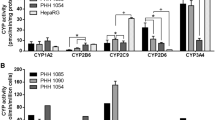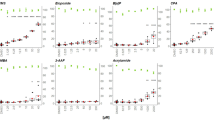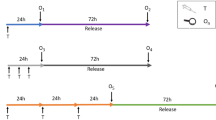Abstract
In vitro genotoxicity testing that employs metabolically active human cells may be better suited for evaluating human in vivo genotoxicity than current bacterial or non-metabolically active mammalian cell systems. In the current study, 28 compounds, known to have different genotoxicity and carcinogenicity modes of action (MoAs), were evaluated over a wide range of concentrations for the ability to induce DNA damage in human HepG2 and HepaRG cells. DNA damage dose–responses in both cell lines were quantified using a combination of high-throughput high-content (HTHC) CometChip technology and benchmark dose (BMD) quantitative approaches. Assays of metabolic activity indicated that differentiated HepaRG cells had much higher levels of cytochromes P450 activity than did HepG2 cells. DNA damage was observed for four and two out of five indirect-acting genotoxic carcinogens in HepaRG and HepG2 cells, respectively. Four out of seven direct-acting carcinogens were positive in both cell lines, with two of the three negatives being genotoxic mainly through aneugenicity. The four chemicals positive in both cell lines generated HTHC Comet data in HepaRG and HepG2 cells with comparable BMD values. All the non-genotoxic compounds, including six non-genotoxic carcinogens, were negative in HepaRG cells; five genotoxic non-carcinogens also were negative. Our results indicate that the HTHC CometChip assay detects a greater proportion of genotoxic carcinogens requiring metabolic activation (i.e., indirect carcinogens) when conducted with HepaRG cells than with HepG2 cells. In addition, BMD genotoxicity potency estimate is useful for quantitatively evaluating CometChip assay data in a scientifically rigorous manner.





Similar content being viewed by others
References
Antherieu S, Chesne C, Li R et al (2010) Stable expression, activity, and inducibility of cytochromes P450 in differentiated HepaRG cells. Drug Metab Dispos 38(3):516–525
Ates G, Mertens B, Heymans A et al (2018) A novel genotoxin-specific qPCR array based on the metabolically competent human HepaRG cell line as a rapid and reliable tool for improved in vitro hazard assessment. Arch Toxicol 92(4):1593–1608
Badisa VL, Latinwo LM, Odewumi CO et al (2007) Mechanism of DNA damage by cadmium and interplay of antioxidant enzymes and agents. Environ Toxicol 22(2):144–151
Bryce SM, Bernacki DT, Bemis JC, Dertinger SD (2016) Genotoxic mode of action predictions from a multiplexed flow cytometric assay and a machine learning approach. Environ Mol Mutagen 57(3):171–189
Cerec V, Glaise D, Garnier D et al (2007) Transdifferentiation of hepatocyte-like cells from the human hepatoma HepaRG cell line through bipotent progenitor. Hepatology 45(4):957–967
Cheung YL, Snelling J, Mohammed NN, Gray TJ, Ioannides C (1996) Interaction with the aromatic hydrocarbon receptor, CYP1A induction, and mutagenicity of a series of diaminotoluenes: implications for their carcinogenicity. Toxicol Appl Pharmacol 139(1):203–211
Coppinger WJ, Brennan SA, Carver JH, Thompson ED (1984) Locus specificity of mutagenicity of 2,4-diaminotoluene in both L5178Y mouse lymphoma and AT3-2 Chinese hamster ovary cells. Mutat Res 135(2):115–123
Dierks EA, Stams KR, Lim HK, Cornelius G, Zhang H, Ball SE (2001) A method for the simultaneous evaluation of the activities of seven major human drug-metabolizing cytochrome P450s using an in vitro cocktail of probe substrates and fast gradient liquid chromatography tandem mass spectrometry. Drug Metab Dispos 29(1):23–29
Ge J, Chow DN, Fessler JL, Weingeist DM, Wood DK, Engelward BP (2015) Micropatterned comet assay enables high throughput and sensitive DNA damage quantification. Mutagenesis 30(1):11–19
Gollapudi BB, Johnson GE, Hernandez LG et al (2013) Quantitative approaches for assessing dose–response relationships in genetic toxicology studies. Environ Mol Mutagen 54(1):8–18
Guillouzo A, Corlu A, Aninat C, Glaise D, Morel F, Guguen-Guillouzo C (2007) The human hepatoma HepaRG cells: a highly differentiated model for studies of liver metabolism and toxicity of xenobiotics. Chem Biol Interact 168(1):66–73
Guo X, Heflich RH, Dial SL, Richter PA, Moore MM, Mei N (2015) Quantitative analysis of the relative mutagenicity of five chemical constituents of tobacco smoke in the mouse lymphoma assay. Mutagenesis 31(3):287–296
Guo X, Heflich RH, Dial SL, De M, Richter PA, Mei N (2018a) Quantitative differentiation of whole smoke solution-induced mutagenicity in the mouse lymphoma assay. Environ Mol Mutagen 59(2):103–113
Guo X, Seo JE, Bryce SM et al (2018b) Comparative genotoxicity of TEMPO and three of its derivatives in mouse lymphoma cells. Toxicol Sci 163(1):214–225
Hardy A, Benford D, Halldorsson T et al (2017) Update: use of the benchmark dose approach in risk assessment. EFSA Journal 15(1):4658
Hartwig A (2010) Mechanisms in cadmium-induced carcinogenicity: recent insights. Biometals 23(5):951–960
Hong YH, Jeon HL, Ko KY et al (2018) Assessment of the predictive capacity of the optimized in vitro comet assay using HepG2 cells. Mutat Res 827:59–67
ICH (2011) Guidance on genotoxicity testing and data interpretation for pharmaceuticals intended for human use S2(R1). ICH Expert Working Group. http://www.ich.org/fileadmin/Public_Web_Site/ICH_Products/Guidelines/Safety/S2_R1/Step4/S2R1_Step4.pdf. Accessed 12 Nov 2018
Jennen DG, Magkoufopoulou C, Ketelslegers HB, van Herwijnen MH, Kleinjans JC, van Delft JH (2010) Comparison of HepG2 and HepaRG by whole-genome gene expression analysis for the purpose of chemical hazard identification. Toxicol Sci 115(1):66–79
Josse R, Rogue A, Lorge E, Guillouzo A (2012) An adaptation of the human HepaRG cells to the in vitro micronucleus assay. Mutagenesis 27(3):295–304
Kawaguchi S, Nakamura T, Yamamoto A, Honda G, Sasaki YF (2010) Is the comet assay a sensitive procedure for detecting genotoxicity? J Nucleic Acids 2010:541050
Khoury L, Zalko D, Audebert M (2013) Validation of high-throughput genotoxicity assay screening using gammaH2AX in-cell western assay on HepG2 cells. Environ Mol Mutagen 54(9):737–746
Khoury L, Zalko D, Audebert M (2016) Evaluation of four human cell lines with distinct biotransformation properties for genotoxic screening. Mutagenesis 31(1):83–96
Kirkland D, Aardema M, Henderson L, Muller L (2005) Evaluation of the ability of a battery of three in vitro genotoxicity tests to discriminate rodent carcinogens and non-carcinogens I. Sensitivity, specificity and relative predictivity. Mutat Res 584(1–2):1–256
Kirkland D, Kasper P, Muller L, Corvi R, Speit G (2008) Recommended lists of genotoxic and non-genotoxic chemicals for assessment of the performance of new or improved genotoxicity tests: a follow-up to an ECVAM workshop. Mutat Res 653(1–2):99–108
Kirkland D, Kasper P, Martus HJ et al (2016) Updated recommended lists of genotoxic and non-genotoxic chemicals for assessment of the performance of new or improved genotoxicity tests. M utat Res Genet Toxicol Environ Mutagen 795:7–30
Krewski D, Acosta D Jr, Andersen M et al (2010) Toxicity testing in the 21st century: a vision and a strategy. J Toxicol Environ Health B Crit Rev 13(2–4):51–138
Le Hegarat L, Dumont J, Josse R et al (2010) Assessment of the genotoxic potential of indirect chemical mutagens in HepaRG cells by the comet and the cytokinesis-block micronucleus assays. Mutagenesis 25(6):555–560
Le Hegarat L, Mourot A, Huet S et al (2014) Performance of comet and micronucleus assays in metabolic competent HepaRG cells to predict in vivo genotoxicity. Toxicol Sci 138(2):300–309
Luch A (2005) Nature and nurture—lessons from chemical carcinogenesis. Nat Rev Cancer 5(2):113–125
MacGregor JT, Frotschl R, White PA et al (2015) IWGT report on quantitative approaches to genotoxicity risk assessment I. Methods and metrics for defining exposure–response relationships and points of departure (PoDs). Mutat Res Genet Toxicol Environ Mutagen 783:55–65
Marrone AK, Tryndyak V, Beland FA, Pogribny IP (2016) MicroRNA responses to the genotoxic carcinogens aflatoxin B1 and benzo[a]pyrene in human HepaRG cells. Toxicol Sci 149(2):496–502
OECD (2015) Guidance document on revisions to OECD genetic toxicology test guidelines. OECD Workgroup of National Coordinators for Test 42 Guidelines (WNT) https://www.oecd.org/chemicalsafety/testing/Genetic%20Toxicology%20Guidance%20Document%20Aug%2031%202015.pdf. Accessed 12 Nov 2018
Quesnot N, Rondel K, Audebert M et al (2016) Evaluation of genotoxicity using automated detection of gammaH2AX in metabolically competent HepaRG cells. Mutagenesis 31(1):43–50
Robison TW, Jacobs A (2009) Metabolites in safety testing. Bioanalysis 1(7):1193–1200
Sand S, Parham F, Portier CJ, Tice RR, Krewski D (2017) Comparison of points of departure for health risk assessment based on high-throughput screening data. Environ Health Perspect 125(4):623–633
Sasaki YF, Nakamura T, Kawaguchi S (2007) What is better experimental design for in vitro comet assay to detect chemical genotoxicity. AATEX 14:499–504
Severin I, Jondeau A, Dahbi L, Chagnon MC (2005) 2,4-Diaminotoluene (2,4-DAT)-induced DNA damage, DNA repair and micronucleus formation in the human hepatoma cell line HepG2. Toxicology 213(1–2):138–146
Sison-Young RL, Mitsa D, Jenkins RE et al (2015) Comparative proteomic characterization of 4 human liver-derived single cell culture models reveals significant variation in the capacity for drug disposition, bioactivation, and detoxication. Toxicol Sci 147(2):412–424
Skipper A, Sims JN, Yedjou CG, Tchounwou PB (2016) Cadmium chloride induces DNA damage and apoptosis of human liver carcinoma cells via oxidative stress. Int J Environ Res Public Health 13(1):88
Sykora P, Witt KL, Revanna P et al (2018) Next generation high throughput DNA damage detection platform for genotoxic compound screening. Sci Rep 8(1):2771
Tryndyak V, Kindrat I, Dreval K, Churchwell MI, Beland FA, Pogribny IP (2018) Effect of aflatoxin B1, benzo[a]pyrene, and methapyrilene on transcriptomic and epigenetic alterations in human liver HepaRG cells. Food Chem Toxicol 121:214–223
Uhl M, Helma C, Knasmuller S (1999) Single-cell gel electrophoresis assays with human-derived hepatoma (HepG2) cells. Mutat Res 441(2):215–224
Valentin-Severin I, Le Hegarat L, Lhuguenot JC, Le Bon AM, Chagnon MC (2003) Use of HepG2 cell line for direct or indirect mutagens screening: comparative investigation between comet and micronucleus assays. Mutat Res 536(1–2):79–90
VICH (2013) VICH topic GL23(R): Studies to evaluate the safety of residues of veterinary drugs in human food: Genotoxicity testing. https://www.ema.europa.eu/documents/scientific-guideline/international-cooperation-harmonisation-technical-requirements-registration-veterinary-medicinal_en-2.pdf. Accessed 12 Nov 2018
Westerink WM, Schoonen WG (2007) Cytochrome P450 enzyme levels in HepG2 cells and cryopreserved primary human hepatocytes and their induction in HepG2 cells. Toxicol In Vitro 21(8):1581–1591
Wills JW, Long AS, Johnson GE et al (2016) Empirical analysis of BMD metrics in genetic toxicology part II: in vivo potency comparisons to promote reductions in the use of experimental animals for genetic toxicity assessment. Mutagenesis 31(3):265–275
Wood DK, Weingeist DM, Bhatia SN, Engelward BP (2010) Single cell trapping and DNA damage analysis using microwell arrays. Proc Natl Acad Sci USA 107(22):10008–10013
Xu J, Oda S, Yokoi T (2018) Cell-based assay using glutathione-depleted HepaRG and HepG2 human liver cells for predicting drug-induced liver injury. Toxicol In Vitro 48:286–301
Zeilinger K, Freyer N, Damm G, Seehofer D, Knospel F (2016) Cell sources for in vitro human liver cell culture models. Exp Biol Med (Maywood) 241(15):1684–1698
Zeller A, Duran-Pacheco G, Guerard M (2017) An appraisal of critical effect sizes for the benchmark dose approach to assess dose–response relationships in genetic toxicology. Arch Toxicol 91(12):3799–3807
Zhang R, Niu Y, Zhou Y (2010) Increase the cisplatin cytotoxicity and cisplatin-induced DNA damage in HepG2 cells by XRCC1 abrogation related mechanisms. Toxicol Lett 192(2):108–114
Acknowledgements
J.E.S. and K.D. were supported by appointments to the Postgraduate Research Program at the National Center for Toxicological Research (NCTR) administered by the Oak Ridge Institute for Science Education through an interagency agreement between the U.S. Department of Energy and the U.S. Food and Drug Administration (FDA). We greatly appreciate Dr. Lei Guo (DBT/NCTR) for generously providing HepG2 cells and thank Drs. Robert H. Heflich, Dayton Petibone, and Elvis-Yane Cuevas-Martinez for their critical review of this article.
Author information
Authors and Affiliations
Corresponding author
Ethics declarations
Conflict of interest
There was no conflict of interest declared.
Disclaimer
The information in this paper is not a formal dissemination of information by the U.S. FDA and does not represent the agency position or policy.
Additional information
Publisher’s Note
Springer Nature remains neutral with regard to jurisdictional claims in published maps and institutional affiliations.
Electronic supplementary material
Below is the link to the electronic supplementary material.
Rights and permissions
About this article
Cite this article
Seo, JE., Tryndyak, V., Wu, Q. et al. Quantitative comparison of in vitro genotoxicity between metabolically competent HepaRG cells and HepG2 cells using the high-throughput high-content CometChip assay. Arch Toxicol 93, 1433–1448 (2019). https://doi.org/10.1007/s00204-019-02406-9
Received:
Accepted:
Published:
Issue Date:
DOI: https://doi.org/10.1007/s00204-019-02406-9




